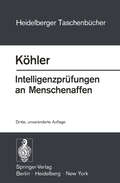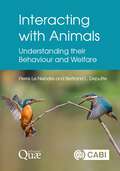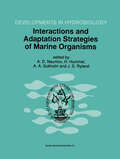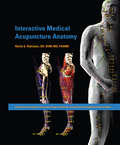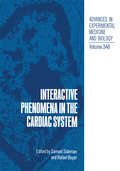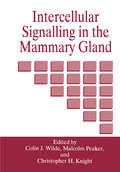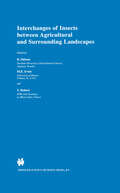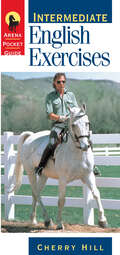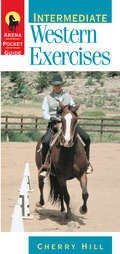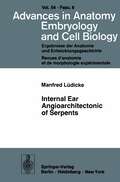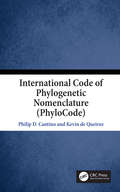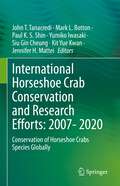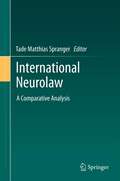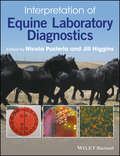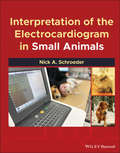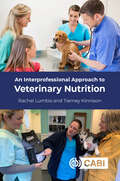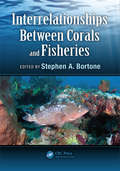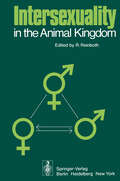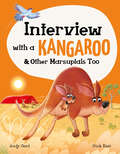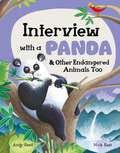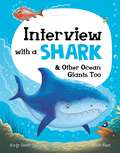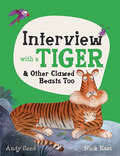- Table View
- List View
Intelligenzprüfungen an Menschenaffen: Mit einem Anhang zur Psychologie des Schimpansen (Heidelberger Taschenbücher #134)
by W. KöhlerInteracting with Animals: Understanding their Behaviour and Welfare
by Dr Pierre Le Neindre Dr Bertrand DeputteAnimal behaviour and, as a result, animal welfare are increasingly complex areas of study, with the diversity of the animal kingdom and new research findings ensuring there is no one, easy answer. Instead, we need to take a holistic approach, combining scientific principles with both philosophical and ethical considerations to develop all-inclusive policies and legislation that decide how society should interact with domestic, farm and native animals. With a focus on domestic animals, while also referring to wild species to reinforce the arguments, this book: · promotes direct observation for those who claim to be interested in animals, their behaviour, and their welfare. · considers the concept of consciousness, how it can be assessed, and how it relates to suffering and animal welfare more widely. · emphasizes the need to understand better how animals behave both with humans and outside of human influence, considering the diversity of behaviour and sensorial capacities across species. · includes author knowledge and expertise across a wide range of animal species, from primates to farm animals, and across animal living situations from intensive to free ranging. We are far from having all the answers, so this book also raises questions that require further research and focus, such as the way animals are likely to act based on their recent and whole-of-life experiences. Still, this review of the topic, an updated translation of the French language work Vivre parmi les animaux, mieux les comprendre, is an invaluable resource for everyone with an interest in animal behaviour and welfare.
Interactions and Adaptation Strategies of Marine Organisms: Proceedings of the 31st European Marine Biology Symposium, held in St. Petersburg, Russia, 9–13 September 1996 (Developments in Hydrobiology #121)
by J. S. Ryland A. A. Sukhotin H. Hummel A. D. NaumovThis volume provides a refereed selection of the proceedings of the 31st European Marine Biology Symposium, held in St. Petersburg, Russia, in September 1996. State-of-the-art reviews and studies on adaptational processes in marine organisms such as adaptations to fluctuations in salinity, temperature, oxygen and pollutants which are reflected in different types of ecophysiological responses and interactions of marine organisms, including predation, parasitism, intraspecific competition and epibiosys were presented at the symposium proceedings. Research from both eastern and western Europe contributed to this project and during the symposium differences in scientific approaches and views between these two groups became apparent. The contents of this volume reflect these differences. Researchers and students in marine biology as well as those involved in coastal management and environmental studies will find this volume of interest.
Interactive Medical Acupuncture Anatomy
by Narda G. RobinsonThis presentation uses anatomically precise, computer-generated reconstructed images of the human body for three-dimensional presentation of acupuncture points and channels. The CD component is fully interactive and allows the user to see through tissue layers, remove tissue layers, and rotate structures so that specific acupuncture points can be v
Interactive Phenomena in the Cardiac System (Advances in Experimental Medicine and Biology #346)
by S. Sideman Rafael BeyerThe cardiac system represents one of the most exciting challenges to human ingenuity. Critical to our survival, it consists of a tantalizing array of interacting phenomena, from ionic transport, membrane channels and receptors through cellular metabolism, energy production to fiber mechanics, microcirculation, electrical activation to the global, clinically observed, function, which is measured by pressure, volume, coronary flow, heart rate, shape changes and responds to imposed loads and pharmaceutical challenges. It is a complex interdisciplinary system requiring the joint efforts of the life sciences, the exact sciences, engineering and technology to understand and control the pathologies involved. The Henry Goldberg Workshops were set up to address these multivariable, multidisciplinary challenges. Briefly, our goals are: To encourage international cooperation and foster interdisciplinary interaction between scientists from the different areas of cardiology; to relate microscale cellular phenomena to the global, clinically manifested cardiac function; to relate conceptual modeling and quantitative analysis to experimental and clinical data; to gain an integrated view of the various interacting parameters, identify missing links, catalyze new questions, and lead to better understanding of the cardiac system. The outstanding success of past workshops has encouraged their continuation. The first Henry Goldberg Workshop, held in Haifa in 1984, introduced the concept of interaction between mechanics, electrical activation, perfusion and metabolism, emphasizing imaging in the clinical environment. The second Workshop, in 1985, discussed the same parameters with a slant towards the control aspects.
Intercellular Signalling in the Mammary Gland: Proceedings Of The 1994 Hannah Symposium Held In Ayr, Scotland, April 13-15, 1994
by Christopher H. Knight MalcolmPeaker Colin J. WildeAll being done, we went to Mrs Shipmans, who is a great butter-woman; and I did see there the most of milke and cream, and the cleanest, that I ever saw in my life (29 May 1661). Among others, Sir Wm. Petty did tell me that in good earnest, he hath in his will left such parts of his estate to him that could invent such and such things -as among others, that could discover truly the way of milk coming into the breasts of a woman ... (22 March 1665). My wife tells me that she hears that my poor aunt James hath had her breast cut off here in tow- her breast having long been out of order (5 May 1665). From the Diary of Samuel Pepys, published as The Shorter Pepys (edited by R. Latham), Penguin Books (1987) The long-standing ultimate importance of research on the mammary gland is illustrated by the importance attached to cows' milk for human consumption, to human lactation and to breast cancer by Samuel Pepys and his contemporaries in the middle of the 17th century. Research has tended to develop in isolation in these three areas of continuing contemporary importance largely because in most countries, the underlying science of agricultural productivity is funded separately from the underlying science of human health and welfare.
Interchanges of Insects between Agricultural and Surrounding Landscapes
by B. S. Ekbom Michael E. Irwin Y. RobertThe chapters in this book were developed from some of the lectures presented at a sym posium at the XX International Congress of Entomology held in Florence, Italy in August 1996. The purpose of the symposium was to discuss the impact of evolving modern agricultural landscapes on the insect species, of both economic and ecological importance, that utilize that habitat. Agricultural policy, to some extent, influences the choices that farmers make and thereby the shape of the agricultural landscape. In order to move toward more sustainable agro ecosystems future policy makers will have to consider the history of land use, consumer demands for both environmentally sound and affordable products, and the conservation of biological diversity. I would hope the information contained in this book will help stimulate discussion about the consequences of policy decisions on our agricultural landscapes and their insect inhabitants. I thank all the speakers from the symposium and in particular those that have been able to contribute chapters to this book. There have been many delays, most due to circumstances beyond anyone's control. I would like to express my appreciation to Gloria Verhey and Patrick Dumont for taking care of the book in these final months. CHAPTER I INTERCHANGES OF INSECTS BETWEEN AGRICULTURAL AND SURROUNDING LANDSCAPES BARBARA EKBOM Department of Entomology, Swedish University of Agricultural Sciences, Uppsala, Sweden 1.
Intermediate English Exercises
by Cherry HillWith this pocket-sized guide in hand, you'll find it easy to develop and perfect your English riding skills. Cherry Hill's exercises will help you learn to hone balance and precise use of aids, improve bending, polish transitions, develop lateral work, and begin collection.
Intermediate Western Exercises
by Cherry HillTake your riding to the next level! Hone balance, tighten transitions, and begin collection as you develop your Western riding skills. In this equestrian workbook, veteran trainer Cherry Hill presents a series of focused exercises that include clearly stated goals, illustrated directions, arena maps, and appropriate safety concerns. With a pocket-sized trim perfect for easy reference in the saddle, this book is designed to help you improve your riding form and maximize the benefits of your training sessions.
Internal Ear Angioarchitectonic of Serpents (Advances in Anatomy, Embryology and Cell Biology #54/6)
by M. LüdickeInternational Code of Phylogenetic Nomenclature (PhyloCode): A Phylogenetic Code of Biological Nomenclature
by Kevin de Queiroz Philip D. CantinoThe PhyloCode is a set of principles, rules, and recommendations governing phylogenetic nomenclature, a system for naming taxa by explicit reference to phylogeny. In contrast, the current botanical, zoological, and bacteriological codes define taxa by reference to taxonomic ranks (e.g., family, genus) and types. This code will govern the names of clades; species names will still be governed by traditional codes. The PhyloCode is designed so that it can be used concurrently with the rank-based codes. It is not meant to replace existing names but to provide an alternative system for governing the application of both existing and newly proposed names. Key Features Provides clear regulations for naming clades Based on expressly phylogenetic principles Complements existing codes of nomenclature Eliminates the reliance on taxonomic ranks in favor of phylogenetic relationships Related Titles: Rieppel, O. Phylogenetic Systematics: Haeckel to Hennig (ISBN 978-1-4987-5488-0) de Queiroz, K., Cantino, P. D. and Gauthier, J. A. Phylonyms: A Companion to the PhyloCode (ISBN 978-1-138-33293-5).
International Code of Phylogenetic Nomenclature (PhyloCode): A Phylogenetic Code of Biological Nomenclature
by Kevin de Queiroz Philip D. CantinoThe PhyloCode is a set of principles, rules, and recommendations governing phylogenetic nomenclature, a system for naming taxa by explicit reference to phylogeny. In contrast, the current botanical, zoological, and bacteriological codes define taxa by reference to taxonomic ranks (e.g., family, genus) and types. This code will govern the names of clades; species names will still be governed by traditional codes. The PhyloCode is designed so that it can be used concurrently with the rank-based codes. It is not meant to replace existing names but to provide an alternative system for governing the application of both existing and newly proposed names. Key Features Provides clear regulations for naming clades Based on expressly phylogenetic principles Complements existing codes of nomenclature Eliminates the reliance on taxonomic ranks in favor of phylogenetic relationships Related Titles: Rieppel, O. Phylogenetic Systematics: Haeckel to Hennig (ISBN 978-1-4987-5488-0) de Queiroz, K., Cantino, P. D. and Gauthier, J. A. Phylonyms: A Companion to the PhyloCode (ISBN 978-1-138-33293-5).
International Horseshoe Crab Conservation and Research Efforts: Conservation of Horseshoe Crabs Species Globally
by John T. Tanacredi Mark L. Botton Paul K. S. Shin Yumiko Iwasaki Siu Gin Cheung Kit Yue Kwan Jennifer H. MatteiThe first International Conference on Horseshoe Crab’s Conservation conducted at Dowling College, USA, (2007) and it’s proceedings published by Springer in 2009, prompted the continued research and conservation efforts presented at subsequent conferences and colloquium in Hong Kong, Taiwan, (2011); San Diego, CA, (2014), (CERF); Japan, Sasebo (2015) and an accepted inclusion for a special session on Horseshoe Crabs at the 2017 CERF Conference held in Providence, RI, USA. All these aforementioned conferences contributed manuscripts, posters, workshop “position papers”, and oral presentations the majority of which have not been published in total. In 2015, Carmichael et al. had published by Springer the majority of manuscripts from the 2011 Hong Kong / Taiwan conference. However, workshop results and all subsequent presentations and workshops were not. The Japan conference presented over 40 papers alone. A collection of all workshop summaries, poster presentations and new manuscript submittals (San Diego, CA; Sasebo, Japan; and Providence, RI) as well as products prepared for the IUCN World Congress in Hawaii, (2016), are included potential contributions for review in this compilation now available for global distribution in this Springer Nature publication.The “Proceedings of International Conferences on the Biology and Conservation of Horseshoe Crabs”, thus contains over 50 manuscripts and a diversified collection of documents, photos and memorabilia covering all four of the horseshoe crab species globally: their biology, ecology evolution, educational, and societal importance. This book exposes the impacts that humans have imposed on all four of these species, revealing through the coordinated effort of horseshoe crab scientists with the IUCN, of the worldwide need for a clear conservative effort to protect these paleo- survival organisms from a looming extinction event. Biologists, conservationists, educators, and health professionals will all welcome this book not only for exploration of its pharmacological interest, but also for the mystery of their longevity. This book also clarifies the future research needs and the conservation agenda for the species worldwide. Anyone working or studying estuaries on a global scale, will need to obtain this seminal work on horseshoe crabs.
International Neurolaw: A Comparative Analysis
by Tade Matthias Matthias SprangerWhereas the past few years have repeatedly been referred to as the “era of biotechnology”, most recently the impression has emerged that at least the same degree of attention is being paid to the latest developments in the field of neurosciences. It has now become nearly impossible to maintain an overview of the number of research projects dealing with the functionality of the brain – for example concerning its organizational structure – or projects dealing with the topics of legal responsibility, brain-computer interface applications, neuromarketing, lie detection or mind reading. These procedures are connected to a number of legal questions concerning the framework conditions of research projects as well as the right approach to the findings generated. Given the primary importance of the topic for the latest developments, it is essential to compare the different legal systems and strategies that they offer for dealing with these legal implications. Therefore, the book International Neurolaw – A Comparative Analysis contains several country reports from around the world, as well as those of international organizations such as UNESCO, in order to show the different legal approaches to the topic and possible interactions.
Interpretation of Equine Laboratory Diagnostics
by Nicola Pusterla Jill HigginsInterpretation of Equine Laboratory Diagnostics offers a comprehensive approach to equine laboratory diagnostics, including hematology, clinical chemistry, serology, body fluid analysis, microbiology, clinical parasitology, endocrinology, immunology, and molecular diagnostics. Offers a practical resource for the accurate interpretation of laboratory results, with examples showing real-world applications Covers hematology, clinical chemistry, serology, body fluid analysis, microbiology, clinical parasitology, endocrinology, immunology, and molecular diagnostics Introduces the underlying principles of laboratory diagnostics Provides clinically oriented guidance on performing and interpreting laboratory tests Presents a complete reference to establish and new diagnostic procedures Offers a practical resource for the accurate interpretation of laboratory results, with examples showing real-world applications Covers hematology, clinical chemistry, serology, body fluid analysis, microbiology, clinical parasitology, endocrinology, immunology, and molecular diagnostics Introduces the underlying principles of laboratory diagnostics Provides clinically oriented guidance on performing and interpreting laboratory tests Presents a complete reference to established and new diagnostic procedures
Interpretation of Equine Laboratory Diagnostics
by Nicola Pusterla Jill HigginsInterpretation of Equine Laboratory Diagnostics offers a comprehensive approach to equine laboratory diagnostics, including hematology, clinical chemistry, serology, body fluid analysis, microbiology, clinical parasitology, endocrinology, immunology, and molecular diagnostics. Offers a practical resource for the accurate interpretation of laboratory results, with examples showing real-world applications Covers hematology, clinical chemistry, serology, body fluid analysis, microbiology, clinical parasitology, endocrinology, immunology, and molecular diagnostics Introduces the underlying principles of laboratory diagnostics Provides clinically oriented guidance on performing and interpreting laboratory tests Presents a complete reference to establish and new diagnostic procedures Offers a practical resource for the accurate interpretation of laboratory results, with examples showing real-world applications Covers hematology, clinical chemistry, serology, body fluid analysis, microbiology, clinical parasitology, endocrinology, immunology, and molecular diagnostics Introduces the underlying principles of laboratory diagnostics Provides clinically oriented guidance on performing and interpreting laboratory tests Presents a complete reference to established and new diagnostic procedures
Interpretation of the Electrocardiogram in Small Animals
by Nick A. SchroederInterpretation of the Electrocardiogram in Small Animals Explore this easy-to-follow clinical manual on how to interpret electrocardiograms in canine and feline patientsInterpretation of the Electrocardiogram in Small Animals delivers a simplified and accessible approach to electrocardiography interpretation for veterinarians treating dogs and cats. This practical manual covers a comprehensive list of arrhythmias and associated phenomena using an easy-to-follow format, with hundreds of electrocardiograms and ladder diagrams supporting the text.The book focuses on the clinical applications of electrocardiographic interpretation, with less emphasis on physics and subcellular mechanisms, making the book a useful patient-side resource. Interpretation of the Electrocardiogram in Small Animals offers readers an up-to-date understanding and knowledge of common and rare phenomena alike.Beginning with a description of the single cardiac cycle as illustrated by surface EKG, the book moves on to describe variations on the P-QRS-T complex that occur in response to chamber enlargement and hypertrophy. Readers will also benefit from the inclusion of:A detailed discussion of aberrancy and its differentiation from ventricular ectopyA thorough exploration of arrhythmias and conduction disorders including escape mechanisms, atrioventricular block, extrasystoles, accelerated rhythms, tachycardias, flutter and fibrillationAn examination of pacemaker basics, as well as a few common abnormalities and pacemaker problems, including undersensing, oversensing, and failure to captureInterpretation of the Electrocardiogram in Small Animals is a convenient, one-stop reference for the interpretation of electrocardiography in small animals for veterinary students, residents, and specialists as well as for small animal general practitioners.
Interpretation of the Electrocardiogram in Small Animals
by Nick A. SchroederInterpretation of the Electrocardiogram in Small Animals Explore this easy-to-follow clinical manual on how to interpret electrocardiograms in canine and feline patientsInterpretation of the Electrocardiogram in Small Animals delivers a simplified and accessible approach to electrocardiography interpretation for veterinarians treating dogs and cats. This practical manual covers a comprehensive list of arrhythmias and associated phenomena using an easy-to-follow format, with hundreds of electrocardiograms and ladder diagrams supporting the text.The book focuses on the clinical applications of electrocardiographic interpretation, with less emphasis on physics and subcellular mechanisms, making the book a useful patient-side resource. Interpretation of the Electrocardiogram in Small Animals offers readers an up-to-date understanding and knowledge of common and rare phenomena alike.Beginning with a description of the single cardiac cycle as illustrated by surface EKG, the book moves on to describe variations on the P-QRS-T complex that occur in response to chamber enlargement and hypertrophy. Readers will also benefit from the inclusion of:A detailed discussion of aberrancy and its differentiation from ventricular ectopyA thorough exploration of arrhythmias and conduction disorders including escape mechanisms, atrioventricular block, extrasystoles, accelerated rhythms, tachycardias, flutter and fibrillationAn examination of pacemaker basics, as well as a few common abnormalities and pacemaker problems, including undersensing, oversensing, and failure to captureInterpretation of the Electrocardiogram in Small Animals is a convenient, one-stop reference for the interpretation of electrocardiography in small animals for veterinary students, residents, and specialists as well as for small animal general practitioners.
An Interprofessional Approach to Veterinary Nutrition
by Rachel Lumbis Tierney KinnisonIn veterinary practice, the interface between veterinarians, veterinary nurses or technicians, and paraprofessional team members is crucial. It influences patient care, incidence of medical errors, client satisfaction, success of the veterinary practice and revenue generation. Ensuring a coherent approach to the maintenance of animal health and wellbeing is of paramount importance, yet challenges such as interprofessional prejudice, misunderstanding of motivations, and a lack of recognition, respect, empowerment or trust, can prevent best practice. Nutrition is one of the most important considerations in the maintenance of health, and plays a critical role in disease management, patient recovery and hospital outcome; a reflection of its recognition as the fifth vital assessment. Owners are increasingly aware of the role of nutrition in optimising pet health, yet considerable misinformation can make this one of the most difficult aspects of pet ownership. Playing a central role as a source of expert information, veterinary healthcare teams must rise to the challenge of optimising pet nutrition. Effective interprofessional communication and collaboration is considered a key factor in the successful implementation of nutritional assessment, and a positive team environment founded on respect, trust and mutual support helps overcome challenges and provide the best outcome for both pets and their owners. This book provides evidence-based theory in an accessible and practical way to help veterinary healthcare teams implement interprofessional approaches to nutritional care and support.
Interrelationships Between Corals and Fisheries
by Ph.D., Stephen BortoneInterrelationships Between Corals and Fisheries is derived from a workshop held by the Gulf of Mexico Fishery Management Council in Tampa, Florida in May 2013, where world authorities came together to discuss the current problems in managing tropical fisheries and offered suggestions for future directions for both researchers and environmental reso
Intersexuality in the Animal Kingdom
by R. ReinbothWhen Richard Goldschmidt' coined the term "intersexuality" in 1915, he intended it to apply to normally dioecious species which exhibit some kind of mixture between male and female characters. However, as knowledge of the bewildering variability present in the sexual orga nization of members of the animal kingdom has increased, the original meaning of the word has changed. Today many authors define inter sexuality as "the presence of both male and female characteristics, or of intermediate sexual characteristics, in a single individual".2 This more extensive and widely accepted concept justifies the title of our book •. Among all the anatomical and physiological features of living organisms the reproductive system has a unique importance for the perpetuation of the species. Conversely, reproductive processes are of little or no account for the viability of the individual. Therefore, within the framework of general biology reproduction has all too often been looked at solely from the point of view of genetics. Lively discussions about genotypic versus phenotypic sex determination long dominated the sci entific literature on sexuality in animals; this one-sided emphasis has tended to obscure many important facets of an organism's ability to reproduce. Recent developments in current biological research have brought the classic problem of sex differentiation into focus again, and the rapid progress being made in comparative endocrinology has added a new di mension to the study of reproductive biology.
Interview with a Kangaroo: And Other Marsupials Too (Interview with a… #3)
by Andy SeedIf you could talk to animals, what would you ask? Get familiar with 10 extraordinary marsupials as they step up to the mic and share their habits, behaviour, likes and dislikes, favourite foods, and more. Each animal has its own story to tell… and its own attitude!In this fun and fact-filled book, bite-sized text in a question-and-answer format is paired with colourful and engaging illustrations throughout, perfect for emerging or reluctant readers, or any young animal enthusiast who enjoys a bit of humour!Features 'interviews' with a kangaroo, koala, Virginia opossum, Tasmanian Devil, numbat, bandicoot, sugar glider, quokka and spotted cuscus. Plus, ideas for how to do your bit to help endangered species.Look out for other titles in the series: Interview with a Tiger and Interview with a Shark!
Interview with a Panda: And Other Endangered Animals Too (Interview with a… #4)
by Andy SeedIf you could talk to animals, what would you ask?Get familiar with 10 endangered animals as they step up to the mic and share their habits, behaviour, likes and dislikes, favourite foods, and more. Each animal has its own story to tell... and its own attitude!In this fun and fact-filled book, bite-sized text in a question-and-answer format is paired with colourful and engaging illustrations throughout, perfect for emerging or reluctant readers, or any young animal enthusiast who enjoys a bit of humour!Features 'interviews' with a giant panda, green turtle, black rhino, flying fox, Sumatran elephant, Cuban crocodile, tiger chameleon, kakapo and Western Nimba toad. Plus, ideas for how to do your bit to help endangered species.Look out for other titles in the series: Interview with a Tiger, Interview with a Shark, Interview with a Kangaroo!
Interview with a Shark: And Other Ocean Giants Too (Interview with a… #2)
by Andy SeedIf you could talk to animals, what would you ask?Get familiar with 10 extraordinary ocean giants as they step up to the mic and share their habits, behaviour, likes and dislikes, favourite foods, and more. Each animal has its own story to tell... and its own attitude!In this fun and fact-filled book, bite-sized text in a question-and-answer format is paired with colourful and engaging illustrations throughout, perfect for emerging or reluctant readers, or any young animal enthusiast who enjoys a bit of humour!Features 'interviews' with a great white shark, blue whale, orca, sunfish, giant squid, narwhal, manta ray, octopus, conger eel, and angler fish. Plus, ideas for how to do your bit to help endangered species.Look out for other titles in the series: Interview with a Tiger and Other Clawed Beasts Too and Interview with a Kangaroo and Other Marsupials Too.
Interview with a Tiger: and Other Clawed Beasts too (Interview with a… #1)
by Andy Seed'Quirky and surprising ... A must for any animal lover or budding conservationist' - BookTrustLonglisted for the UKLA Book Awards 2022 and featured in BookTrust's Great Books Guide 2021.If you could talk to animals, what would you ask? 'What are your top tips for catching prey, Tiger?' 'How do you help yourself to honey, Honey Badger?' 'Why do you howl, Wolf?'Get familiar with 10 fierce and furry beasts as they step up to the mic and share their habits, behaviour, likes and dislikes, favourite foods, and more. Each animal has its own story to tell... and its own attitude!In this fun and fact-filled book, bite-sized text in a question-and-answer format is paired with colourful and engaging illustrations throughout, perfect for emerging or reluctant readers, or any young animal enthusiast who enjoys a bit of humour! Features 'interviews' with a tiger, wolf, honey badger, giant armadillo, lion, jaguar, giant anteater, snow leopard, polar bear, and three-toed sloth. Plus, ideas for how to do your bit to help endangered species and their habitats.Look out for other titles in the series: Interview with a Shark and Other Ocean Creatures Too and Interview with a Kangaroo and Other Marsupials Too.
